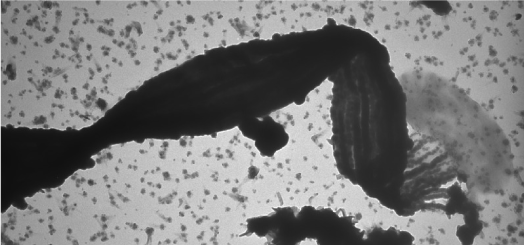

Researchers at the University of Minnesota, St. Paul, have coaxed a species of bacteria into trading their usual diet of partially-oxidized iron for a small current of electricity–a trick that may eventually make the microorganisms useful producers of biofuels.
The bacterium involved in the study was Mariprofundus ferrooxydans, a species that makes its home around hydrothermal vents on the seafloor. Like other iron-oxidizing bacteria, M. ferrooxydans relies on a form of soluble iron, called ferrous iron, or FeII, as a source of the electrons it needs to breathe. When plenty of oxygen is present, ferrous iron readily gives up its extra electron to the oxygen, to become the more stable FeIII, or ferric iron–the kind of iron oxide we know of as rust. But in lower-oxygen environments, M. ferrooxydans’ can do oxygen’s job for it, thereby gaining energy from the extra electron.
Since previous studies had suggested that the electron-thieving microbes use proteins on the outside of their cells to carry out the heist, the Minnesota scientists decided to try feeding the electrons directly to the cell’s surface.
In their experiment, the researchers deposited some M. ferrooxydans onto the surface of an electrode, which was tuned to release electrons at the same energy level that FeII would provide. To get the organisms started in their new habitat, the scientists also added some of the bacterium’s natural food–FeII–to the mix.
After letting the microbes multiply over the surface of the electrode for four weeks, they scraped some away and started a new colony on an electrode with no FeII around. Amazingly, the bacteria continued to thrive, even after some were transplanted onward to a third electrode. Some nutrients were still provided to this colony, the study noted, but in amounts much too small to support the bacterium’s apparent growth.

The results show that bacteria like M. ferrooxydans are capable of using electricity from electrodes to capture carbon dioxide and replicate. What makes this interesting, from an energy-hungry human perspective, is that, by taking in carbon dioxide and using it to create new cells, the bacteria are essentially using electricity to store carbon in a form humans could use as fuel.
Eventually, the researchers hope to scale up this method to produce a new kind of biofuel out of the microbes, using electricity from solar cells or other non-fossil sources. Such a feat would come in tremendously handy for a variety of purposes–for one, it would provide a way to store excess energy generated by wind and solar farms.
Of course, the challenges of “scaling up” pretty much any biofuel method are not lost on the researchers. As one scientist involved in the study told The American Society for Microbiology, who published the findings in their journal Mbio, “If there are 100 steps to making this work–this is step one.”
